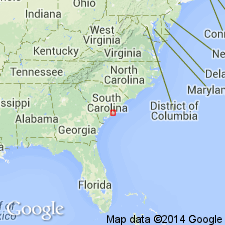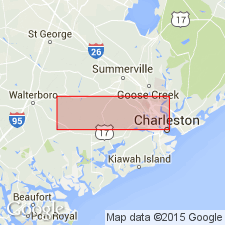
- Usage in publication:
-
- Chandler Bridge Formation*
- Modifications:
-
- Named
- Biostratigraphic dating
- Dominant lithology:
-
- Sand
- AAPG geologic province:
-
- Atlantic Coast basin
Summary:
A thin sequence of noncalcareous arenaceous beds in Dorchester, Berkeley, and Charleston Cos., SC, is here named Chandler Bridge Formation. It contains three conformable beds: 1) basal, yellowish-brown, clayey, quartz-phosphate sand; 2) middle, gray, clayey, poorly-compacted, quartz-phosphate sand; 3) upper, gray, clayey, well-compacted, quartz-phosphate sand. Disconformably overlies the Ashley Member of the Cooper Formation; disconformably underlies surficial Pleistocene deposits. Thickness is 5 m. Age is late Oligocene (Chattian), based on cetacean fauna.
Source: GNU records (USGS DDS-6; Reston GNULEX).

- Usage in publication:
-
- Chandler Bridge Formation
- Modifications:
-
- Areal extent
- Biostratigraphic dating
- AAPG geologic province:
-
- Atlantic Coast basin
Summary:
The westernmost occurrence of the Chandler Bridge identified so far is associated with barrow pits south of Round "O", SC. Unit is probably not laterally continuous, but is preserved as lenticular erosional remnants in depressions of the Ashley Formation. Uppermost gravel lithofacies is interpreted as late Oligocene (Chattian). Pollen analyses in this study of phosphate nodules from a lag bed unconformably overlying these gravel deposits also suggests that the Chandler Bridge is probably no older than late Oligocene. Tentatively correlated with deposits referred to in this report as the Upland Unit.
Source: GNU records (USGS DDS-6; Reston GNULEX).
For more information, please contact Nancy Stamm, Geologic Names Committee Secretary.
Asterisk (*) indicates published by U.S. Geological Survey authors.
"No current usage" (†) implies that a name has been abandoned or has fallen into disuse. Former usage and, if known, replacement name given in parentheses ( ).
Slash (/) indicates name conflicts with nomenclatural guidelines (CSN, 1933; ACSN, 1961, 1970; NACSN, 1983, 2005, 2021). May be explained within brackets ([ ]).

